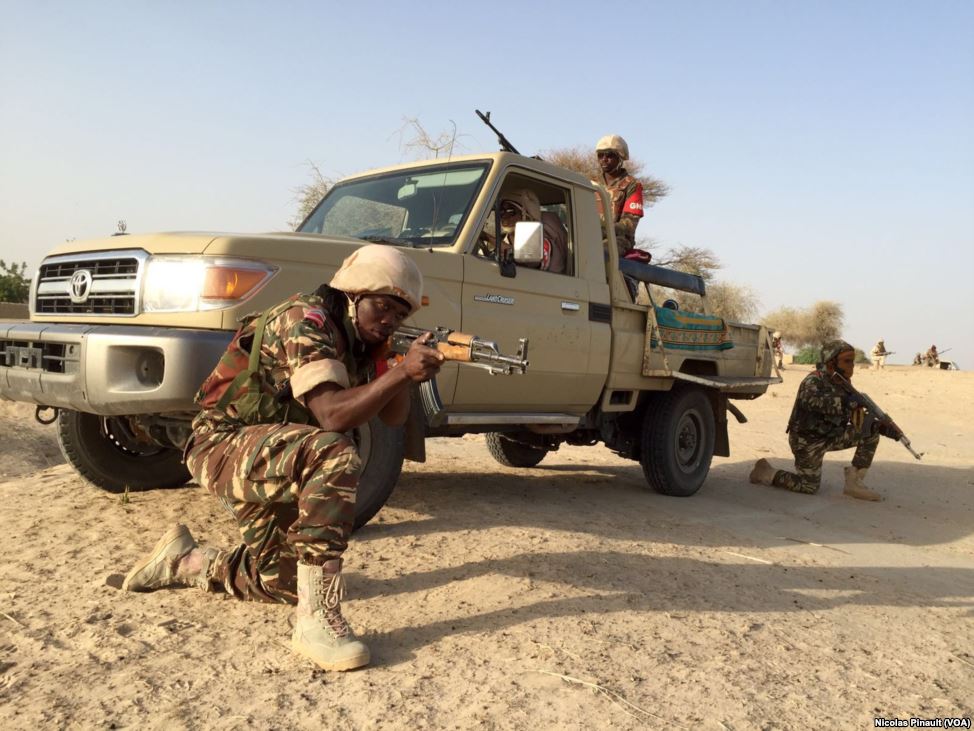 Nigerian soldiers fighting Boko Haram; Photo Courtesy of VOA/Nicolas Pinault
Nigerian soldiers fighting Boko Haram; Photo Courtesy of VOA/Nicolas Pinault
Don’t Forget About Boko Haram: A 2019 Update
On Monday, June 17th, Boko Haram once again made headlines when it killed 30 people and injured over 40 in a triple suicide bombing in Konduga, Nigeria.
Once named the world’s deadliest terrorist group, Boko Haram continues to be one of the most active organizations in the world. Since 2011, Boko Haram has been responsible for 37,500 deaths and 2.4 million displaced people. The organization’s most significant activities include the 2011 attack on the UN in Abuja, the 2014 kidnapping of 276 teenage girls, the 2015 massacre of almost 2,000 civilians in Baga, and the 2018 attack on a Nigerian military base which killed over 100 soldiers.
Boko Haram’s Capabilities
Boko Haram uses a variety of tactics, such as kidnappings, shootings, bombings, and beheadings. They may no longer be the world’s most dangerous terrorist organization, but they’re far from defeated. Throughout the last few years, the group has been launching more frequent, small-scale attacks. These actions result in relatively few causalities but continue to instill fear in the civilian population.
Their tactics may have shifted, but Boko Haram’s membership remains strong. U.S. intelligence officials estimate that the organization consists of 4,000 to 6,000 active fighters. Others believe the group could have three times as many members.
Recently, the group has increased its attacks on soft targets and has encouraged women and children to become suicide bombers. The majority of the attacks have occurred in the Borno State, followed by the Far North of Cameroon.
One reason Boko Haram has seen so much recent success is because it continues to recruit in large numbers, particularly around Lake Chad. The Lake Chad basin has deteriorated due to climate change – poverty and violence increased as droughts reduced the size of the lake. As such, Boko Haram has been successful in recruiting the increasingly desperate population. The group offers small loans and promises more substantial rewards to potential recruits.
Boko Haram further recruits by kidnapping young boys and forcing them to join the organization as fighters. It appears that even in today’s technological world, Boko Haram relies little on online recruitment techniques, instead favoring conscription.
Boko Haram in 2019
Thus far in 2019, Boko Haram has conducted a distressing 383 total attacks across Cameroon, Chad, Niger, and Nigeria resulting in 1,747 fatalities (counting its own members killed in action). These attacks have taken various shapes, including battles, explosions/remote violence, strategic developments, and violence against civilians.
The most significant event this year occurred on June 9th, when 300 Boko Haram members fought against military personnel in Cameroon around Lake Chad. This confrontation resulted in the deaths of 16 soldiers, 8 civilians, and 64 Boko Haram members.
Map by Cat Cronin, 2019. Data from the Armed Conflict Location and Event Data Project (ACLED) available at https://www.acleddata.com/data/.
What’s being done to combat Boko Haram?
In 2013, Nigeria’s President launched an offensive against the group, after declaring a state of emergency in three territories. The offensive was not particularly successful, and was troubled by reports of Nigerian troops committing human rights abuses. It is for this reason that other countries delayed offering aid to Nigeria.
Since 2016, the U.S. has taken a more active stance in supporting Nigeria and countering Boko Haram. By early 2016, the U.S. gave $400 million in aid. President Trump furthered the assistance in 2018 by selling a dozen Super Tucano planes to the country to “support its counterterrorism efforts.” The U.S. also sent military personnel to train Nigerian troops to be more effective against the terrorist threat.
Within the region, Cameroon, Chad, and Niger have deployed several thousand troops to aid in combating Boko Haram. This military intervention, called the Multinational Joint Task Force (MNJTF) is run through the African Union (AU) and supported financially by the European Union. The MNJTF has achieved moderate success in reducing the size of the areas the Boko Haram controls.
Yet current efforts are not going nearly far enough to counter the enduring threat of Boko Haram. A delayed response by the international community allowed the group to strengthen and expand. A further lack of cooperation between the Nigerian government and the broader regional area has permitted Boko Haram to thrive. Boko Haram has been successful in capitalizing upon the regional instability and has created a stronger base that it uses to launch attacks. Until the international community catches up, Boko Haram will remain an enormous threat and disturbance to parts of the Sahel region.






